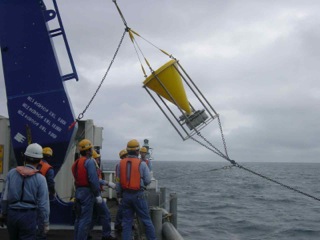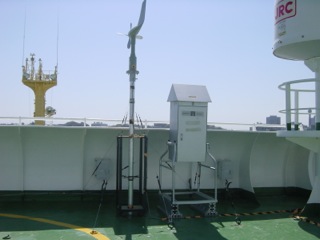3. Methods and Approach
The following scientific methods and approaches are employed in this project.
Role of aerosol in the biological pump. Data and samples regarding the marine biological pump and atmospheric aerosols are collected using research vessels and time-series moorings (Fig. 4).
Spatial and temporal variability in atmospheric aerosol transport and deposition. Atmospheric aerosol particles are sampled and analyzed for chemical composition using multi-axis differential optical absorption spectroscopy and other techniques (High Volume Sampler) on boar the R/V Mirai.
Dust deposition flux and spatiotemporal variation. Numerical simulations of atmospheric dust transport and deposition are conducted during the observational period by using an atmospheric chemical transport model that can treat different types and size classes of aerosol particles. The results are compared with ground-based, at-sea, and satellite observations.
3.1 FY2011
3.1.1. Role of atmospheric aerosols in the biological pump
3.1.1.1 Scientific cruise
In April and July 2011, interdisciplinary observations are conducted at time series stations K2 (subarctic gyre: 47°N, 160°E) and S1 (subtropical gyre: 30°N, 145°E) aboard the R/V Mirai. Measurements includes primary production rate, nutrient concentration, and suspended particle concentration and sinking rate.
3.1.1.2 Time-series observations
Sediment traps deployed at 200, 500 and 5000 m at stations K2 and S1 are recovered, serviced, and re-deployed. Material collected in each trap is analyzed for dry weight and chemical composition. A primary productivity profiler deployed at S1 is recovered and re-deployed. The data obtained is used to examine temporal variability of phytoplankton standing stock, primary production, and optical properties of the water column, including backscatter intensity and light extinction.

3.1.2. Understanding spatiotemporal variations in atmospheric aerosol supply
3.1.2.1. Shipborne observations
Using a high-volume air sampler deployed on the R/V Mirai, atmospheric particles are sampled onto filters every 2–3 days. A wind selector is used to avoid measurement contamination from the ship exhaust. Collected particles are analyzed for spatiotemporal variations in the mass concentration of sulfate, nitrate, black carbon, elemental iron, and other metal elements. The data is used to estimate the origins of iron-containing aerosols by analyzing coarse and fine particle samples separately and combining the results with tracer information, e.g., aluminum indicating dust and carbon monoxide gas indicating industrial sources).

3.1.2.2. Laboratory experiments
Observations of dust deposition have been difficult to achieve, mainly because dust particles could not be discriminated from sea-salt particles by using standard aerosol particle sizing instruments based on light scattering. Using a wide band, integrated bio-aerosol sensor (WIBS4), we investigate separating the two classes of aerosols based on particle shape information.
3.1.3. Aerosol transport
3.1.3.1 Analyzing temporal and spatial variability of aerosol distributions by using satellite data
The temporal and spatial variations in atmospheric aerosol transport of aeolian dust and anthropogenic aerosols from urban areas to the western North Pacific Ocean are studied by analyzing satellite data, including SeaWiFS, MODIS and TOMS. Additionally, the temporal and spatial variability of phytoplankton biomass, primary productivity, and ocean surface physical conditions is derived from multi-sensor satellite data, e.g., ocean color, sea surface temperature, sea surface wind, and photosynthetically active radiation.
3.1.3.2 Development of an aerosol transport model
An aerosol transport model is developed that will include multiple aerosol sources, such as mineral dust and anthropogenic aerosols, based on the chemical weather forecasting system (http://www.jamstec.go.jp/frcgc/gcwm/eng/index.html). Satellite data, e.g., MODIS, is analyzed to investigate the effects of land use change, such as the expansion of semi-arid regions in China, on aerosol source. The influx of dust from land surfaces into the atmosphere is estimated based on soil moisture, soil type, and surface wind data (Shaw et al., Atmos. Environ., 42, 2008). Deposition of natural and anthropogenic aerosol particles over the western North Pacific Ocean is estimated by using numerical simulations. The use of nested scale models is investigated in order to more accurately simulate dust sources from complex terrain, such as the Taklamakan desert and surrounding area.
3.2 FY2012
3.2.1. Role of atmospheric aerosols in the biological pump
In June 2012, time-series stations K2 and S1 are visited aboard the R/V Mirai and interdisciplinary observations were conducted. Mooring systems with sediment traps and a primary production profiler are recovered, serviced, and re-deployed.
3.2.2. Spatiotemporal variability in atmospheric aerosol transport and deposition
Sampling and chemical analysis of atmospheric aerosol particles and in-situ ocean observations are conducted aboard the R/V Mirai. A WIBS4 instrument is used to measure aerosol concentration, size distribution, and shape. An analysis of aerosol origin and transport processes is conducted by comparing aerosol chemical composition over the ocean with aerosol properties observed at Fukue Island and in China.
3.2.3. Estimation of the aerosol deposition flux and spatiotemporal variation
Work to develop an atmospheric aerosol model continued. Model simulations of aerosol spatiotemporal variation are compared with aerosol distribution derived from satellite observations.
3.3 FY2013 (final project year)
Time-series stations K2 and S1 are visited aboard the R/V Mirai in July 2012; interdisciplinary observations are conducted. Mooring systems with sediment traps and a primary production profiler are recovered, serviced, and re-deployed. The data, along with mathematical simulations of atmospheric aerosol distribution and deposition rate, are used to assess the role of aerosols in the biological pump and to predict future conditions.
